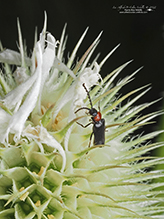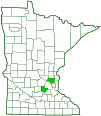lateral-lobed soldier beetle
(Ditemnus latilobus)
Conservation • Description • Habitat • Ecology • Distribution • Taxonomy
|
|
||||||||||||||
Description |
Lateral-lobed soldier beetle is a small, fairly common, early season, soldier beetle. It occurs in the United States from Massachusetts to North Carolina, west to North Dakota and eastern Texas, and in southern Canada from Quebec to Alberta. Adults are active from April through early August in grasslands and forests. Adults are 3⁄16″ to ¼″ (4.5 to 6.5 mm) in length. The body is soft, long, and somewhat flattened. The sides are nearly parallel. The head is black. It is visible from above, not completely concealed by the plate covering the first segment of the thorax (pronotum). The compound eyes are moderately protruding. They are not notched. There are no simple eyes (ocelli). The mouthparts are directed forward. The jaws (mandibles) are long, curved, and reddish yellow. The plate on the face (clypeus) is notched at the middle of the lower margin. The upper lip (labrum) is membranous and may be concealed beneath the clypeus. The antennae have 11 segments. They are black, long, and distinctly sawtoothed. The pronotum is yellowish red, glossy, and much wider than long. The lateral margins are indented before the middle, wider beyond the indentation, and widest at the rear. On the male, there is a large blunt spine in the middle and a larger lobe behind and close to the spine. These are the lobes that give the beetle its common name and species epithet. The surface of the pronotum has sparse small pits (punctures) and sparse, moderately long hairs. The wing covers (elytra) are black, slightly glossy, soft, and long, almost completely covering the abdomen. The sides are almost parallel, slightly wider in the middle and slightly concave near the base. The tips are broadly curved. The surface has transverse wrinkles, small punctures, and moderately dense, moderately long hairs. The legs are long, slender, and entirely black. The end part of each leg (tarsus), corresponding to the foot, has 5 segments. The fourth tarsal segment is deeply lobed and heart shaped. The last tarsal segment has a pair of claws at the tip. The claws are equal in size. |
Size |
Total length: 3⁄16″ to ¼″ (4.5 to 6.5 mm) |
Similar Species |
Habitat |
Grasslands and forests |
Ecology |
Season |
April through early August |
Behavior |
|
Life Cycle |
|
Larva Food |
|
Adult Food |
|
Distribution |
||
|
Sources |
|
| 3/31/2024 | ||
Occurrence |
||
Fairly common |
||
Taxonomy |
|
Order |
Coleoptera (Beetles) |
Suborder |
Polyphaga (Water, Rove, Scarab, Long-horned, Leaf, and Snout Beetles) |
Infraorder |
Elateriformia |
Superfamily |
Elateroidea (click, firefly and soldier beetles) |
Family |
Cantharidae (soldier beetles) |
Subfamily |
Silinae |
Tribe |
Silini |
Genus |
Ditemnus |
Subordinate Taxa |
|
|
|
Synonyms |
|
Silis latiloba |
|
Common Names |
|
lateral-lobed soldier beetle hhick-lobed cantharid |
|
Glossary
Clypeus
On insects, a hardened plate on the face above the upper lip (labrum).
Elytra
The hardened or leathery forewings of beetles used to protect the fragile hindwings, which are used for flying. Singular: elytron.
Labrum
The upper part of the mouth, sometimes considered the lower part of the face, corresponding to the upper lip, on an insect or crustacean.
Ocellus
Simple eye; an eye with a single lens. Plural: ocelli.
Pronotum
The exoskeletal plate on the upper side of the first segment of the thorax of an insect.
Punctate
Dotted with pits (punctures), translucent sunken glands, or colored spots of pigment.
Tarsus
On insects, the last two to five subdivisions of the leg, attached to the tibia; the foot. On spiders, the last segment of the leg. Plural: tarsi.
Visitor Photos |
||
Share your photo of this insect. |
||
This button not working for you? |
||
Alfredo Colon |
||
 |
|
|
MinnesotaSeasons.com Photos |
||
|
||
|
||

Slideshows |
|

Visitor Videos |
||
Share your video of this insect. |
||
This button not working for you? |
||
|
Other Videos |
||
|

Created: 3/31/2024 Last Updated: © MinnesotaSeasons.com. All rights reserved. |


